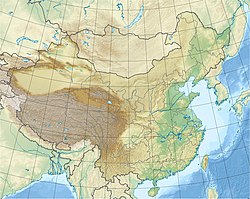Xihoudu
| Location | Shanxi |
|---|---|
| Region | North China |
| Coordinates | 34°41′35″N 110°16′12″E / 34.693056°N 110.27°E |
| Type | Paleolithic |
| Part of | Paleolithic China |
| History | |
| Founded | 1,800,000 years ago |
| Periods | Pleistocene |
Xihoudu (Chinese: 西侯度; pinyin: Xīhóudù) is an archeological site located in the Shanxi Province of China. The site dates to the Paleolithic Age. In total 32 stone implements were found at the site.[1]
Discovery
[edit]In 1929, Chinese prehistoric archaeologist and paleontologist Professor Pei Wenzhong discovered the skull fossil of the "Peking Man" 500,000 years ago at the Zhoukoudian site in Beijing. However, the Paleolithic archaeologist Wang Jian(王建) inferred that there must have been more primitive humans before the "Peking Man". This inference was affirmed by the paleoanthropologist Professor Jia Lanpo(贾兰坡). In order to prove their theoretical inference, Jia Lanpo, Wang Jian and others analyzed from the aspects of paleogeography and paleoclimate, and began to search for human remains in the Nihewan stratum.[2]
In 1959, archaeologists discovered the site on a terrace 170 meters above the river surface on the east bank of the Yellow River in Xihoudu Village, Ruicheng County. Three excavations were carried out in 1961, 1962, and 2005.[3] Dating back 1.8 million years, it is the oldest known Paleolithic cultural sites in China.[4]
In 1983, the Ruicheng County People's Government established the Xihoudu Cultural Relics Protection Group; in 1986, the Shanxi Provincial People's Government announced the Xihoudu Cultural Site as a key cultural relic protection unit in the province; in 1988, the Xihoudu Site was designated as a national key cultural relic Protection unit (third batch).[5] In 2013, the cultural relics department of Ruicheng County, Shanxi Province built the Xihoudu Site Exhibition Hall with a total construction area of about 130 square meters to protect the unearthed cultural relics.[6]
Geography
[edit]The Xihoudu site is located on the sunny slope of Zhongtiao Mountain in the northwest corner of Ruicheng County in the south of Shanxi Province, in the middle reaches of the Yellow River. Archaeologists believe that in ancient times, the climate here was mild and the aquatic plants were abundant; there were ancient Chinese bison, Shanxi woolly rhinoceros, Equus sanmeniensis (ancient horse), gazella blacki (ancient gazelle), Palaeoloxodon namadicus (paleo elephant), Sus lydekkeri, Père David's deer, etc. There are all kinds of fish. Such a natural environment is suitable for human survival and reproduction.[7][8]
Archaeological Site
[edit]A total of 32 stone artifacts were discovered at the Xihoudu site in the 1960s, including stone cores, flakes, and stone tools. They are among the earliest stone tools discovered in China. The stone tooling technology is relatively primitive, the raw material is quartzite of various colors, there are also a small amount of vein quartz and volcanic rock.[9] During more than 50 days of excavation in 2005, more than 1,500 stone products and animal fossil specimens were found.[10] Among the stone products, there are many fine products and standardized products with lighter abrasion and clear strike marks.[11]
Some relics coexisting with stone tools include cut or scraped antlers, as well as burned animal bones, horns and teeth, which are considered to be signs of human use of fire.[12] The history of the ancient Chinese people using fire at the Xihoudu site has advanced 1.1 million years from 500,000 to 700,000 years ago in Zhoukoudian Peking.[13]
The coexisting animal fossils include ostrich, Castoroides, hedgehog, rabbit, Palaeoloxodon namadicus (paleo elephant), Sus lydekkeri (ancient boar), Père David's deer, Axis shansius (ancient deer), flat-fronted elephant (Elephas planifrons), hyena, Shanxi woolly rhinoceros, Elasmotherium, Equus sanmeniensis (ancient horse), Hippotherium, ancient Chinese bisons(Bison palaeosinensis), Leptobos, gazella blacki (ancient gazelle) and Euctenoceros boulei, etc.[14]
Disputes
[edit]After the discovery of the Xihoudu site, it has not been fully recognized by the academic community. There are disagreements and disputes about whether the unearthed stone tools were made by hand. Pei Wenzhong, Zhang Senshui(张森水), etc. believe that the "artificial nature of stone tools cannot be determined" and suspect that it was caused by river collisions[15][16][17][18] Experts from the Shanxi Provincial Institute of Archaeology believe that the most effective way to resolve these disputes and problems is to further excavate to obtain new information.[10] With the progress of archaeological work, the artificial traces of stone products have been determined, and the chronological problem has been solved. The Xihoudu site has become one of the world's first-class Paleolithic archaeological sites.[3]
References
[edit]- ^ Xihoudu Site Archived August 7, 2007, at the Wayback Machine
- ^ "芮城县西侯度遗址:180万年后再现"一堆圣火"". 新浪山西 (in Chinese). 2016-05-17. Retrieved 2017-04-14.
- ^ a b 周学磊; 范锐莉; 郭荣 (2016-05-09). "山西西侯度遗址陈列馆布展 再现原始文明圣火". 中国考古. 中国青年网. Retrieved 2017-04-14.
- ^ 朱祖希 (2014). "历史沿革:华夏文明起源地之一". 美丽山西: 读酷高清插图版. XinXueTang. ISBN 750941279X.
- ^ 惟洛 (2015-01-27). "西侯度遗址". 山西省考古研究所. Archived from the original on 2017-04-12. Retrieved 2017-04-12.
- ^ 王飞航 (2013-12-13). "中国修建展览馆保护旧石器时代西侯度遗址". 新华网. Archived from the original on 2017-04-12. Retrieved 2017-04-12.
- ^ 李雅丽 (2016-05-19). "西侯度:文明圣火在此燃起". 山西新闻网. 凤凰文化. Retrieved 2017-04-14.
- ^ "山西古文化"三个一"之西侯度遗址". 芮城县人民政府. 2016-03-24. Archived from the original on 2017-04-12. Retrieved 2017-04-12.
- ^ 白壽彝 (2017). "第一章 我们的远古祖先". 中國通史: 千萬言版.
- ^ a b 王益人 (2016). "远古遗踪(连载)——山西芮城西侯度遗址发现始末". 文史月刊 (2): 61–64.
- ^ 惟洛 (2015-01-27). "西侯度遗址". 山西省考古研究所. Archived from the original on 2017-04-12. Retrieved 2017-04-14.
- ^ 张学亮 (May 2014). "北方最早远古人类西侯度人". 远古人类:中国最早猿人及遗址. 现代出版社. ISBN 9787514323580.
- ^ "山西将举办西侯度遗址取火等活动展示"古中国"文化". 中国国家博物馆. 中国新闻网. 2016-05-10. Archived from the original on 2014-12-21. Retrieved 2017-04-12.
- ^ 周文顺; 徐宁生 (1998). 河洛文化. 河南: 五洲传播出版社. pp. 390–392. ISBN 7801134400.
- ^ 裴文中.中国猿人究竟是否最原始的“人”——答吴汝康、贾兰坡二先生和其他同志[J].新建设, 1962, (4): 28-41.
- ^ 张森水.关于西侯度的问题[J].人类学学报,1998,17(2):81-93.
- ^ 卫奇.《西侯度》石制品之浅见[J].人类学学报.2000,19(2):85-96.
- ^ 陈哲英.关 《西侯度》存在的问题[J].龙骨坡史前文化志,2000, 2(2):82-86.


